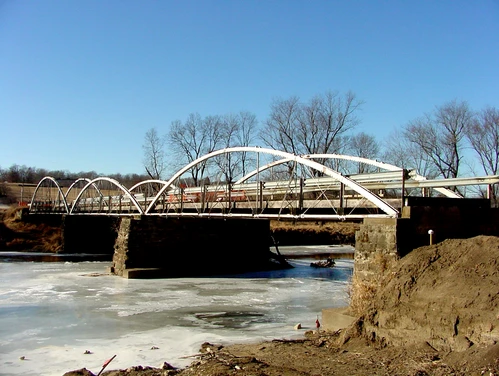- Year constructed: 1877-1879
- Alternate name: Wapsipinicon River Bridge
- Bridge type: Bowstring Through Arch-Truss
- National Register of Historic Places status: Listed
- Length: 296 feet
- Width: 15 feet
- Spans: 3
- FHWA: 206270
- Jurisdiction: Jones County Historical Preservation Commission
- Location: Wapsipinicon State Park over the Wapsipinicon River South of Animosa Iowa, Section 11, T84N-R4W (Fairview Township)
Details
Located at the small village of Hale, this structure crosses the Wapsipinicon River in Hale Township, some six miles northwest of Oxford Junction. This extraordinary three-span bowstring structure is supported by stone abutments and massive piers with concrete vertical extensions and angled cutwaters. The history of the bridge can be traced to 1877. In April of that year the Jones County Board of Supervisors let a comprehensive contract to the King Iron Bridge and Manufacturing Company to furnish all iron bridges in the county from April 1877 until early 1878. Evidently, the Hale location had already been slated for a permanent crossing, because pile driving for the bridge's substructure was begun shortly thereafter. The piling for the center pier was recorded as being "drove and capped" in early fall. The Cleveland, Ohio fabricator used wrought iron components rolled by the Trenton (New Jersey) Iron Works to construct a 100-foot through arch-truss and one shorter pony arch that winter, using King's patented tubular bowstring design. The county evidently changed the bridge's configuration the following spring and contracted with King Bridge to fabricate and erect one additional pony arch to replace the earlier timber approaches. The Hale Bridge was finally completed in June 1879. It has functioned in place since that time, with the replacement of various superstructural members and buttressing and raising of the piers as the most serious alterations.
The bowstring arch-truss was the iron span of choice for Iowa counties in the late 1860s and 1870s. Marketed exclusively throughout the Midwest by such industry giants as the King Iron Bridge and Manufacturing Company and the Wrought Iron Bridge Company, these often-patented bridge configurations featured a wide range of span lengths, economical fabrication cost and relatively quick erection. The proliferation of the bowstring corresponded with the initial development of Iowa's road system; as a result, perhaps thousands of these prototypical iron spans were erected throughout the state. The bowstring had some rather severe structural flaws, however, relating primarily to lateral stability of the arches, and it was largely superseded by the pin-connected truss in the early 1880s. Despite this, some bowstrings were still erected in Iowa in the 1880s, although the number dwindled precipitously by the decade's end. Through subsequent attrition, almost all of Iowa's bowstrings have since been replace and demolished. Now less than twenty remain in place. Through its association with the King Iron Bridge and Manufacturing Company and owing to its multiplicity of spans, the Hale Bridge is both historically and technologically significant as one of the last remaining examples in the state of what was once a mainstay structural type.
Adapted from Hybben, Roise, and Fraser 1992
Areas Served
- Jones
